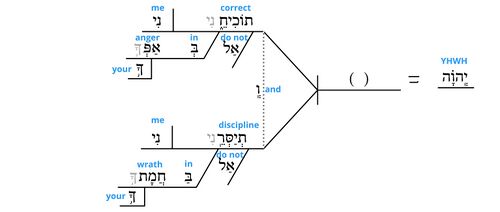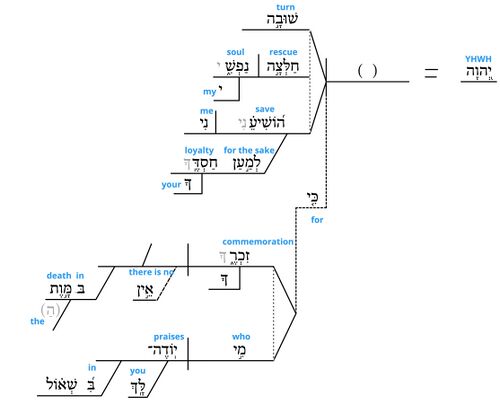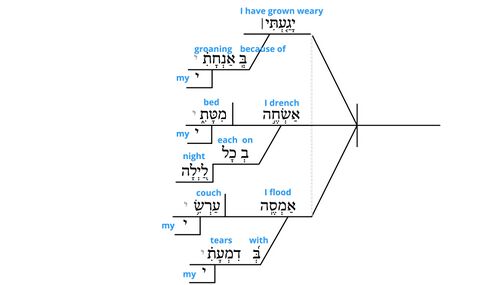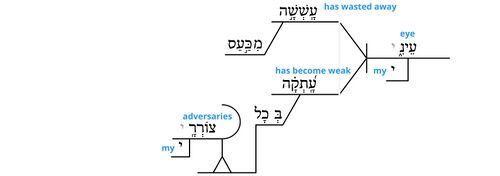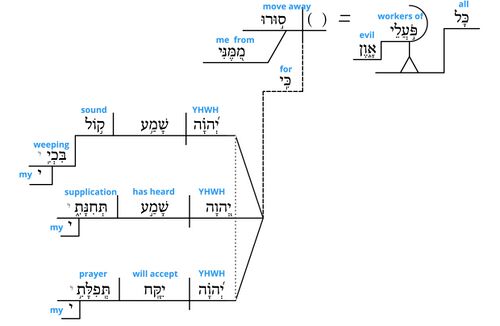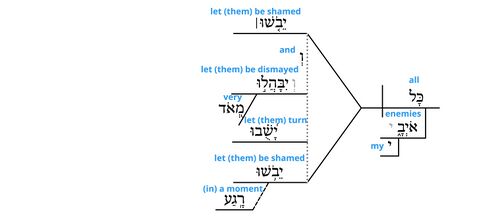Psalm 6 Grammar
Overview
For the most part, the grammar of this Psalm is fairly straightforward. There are some difficulties, however, in v. 2 and v. 4. These are discussed in the notes below.
Grammatical Diagram
| Visualization | Description |
|---|---|
| The clause is represented by a horizontal line with a vertical line crossing through it, separating the subject and the verb. | |
| The object is indicated by a vertical line that does not cross the horizontal line of the clause. Infinitives and participles may also have objects. If the direct object marker (d.o.m.) is present in the text, it appears in the diagram immediately before the object. If the grammar includes a secondary object, the secondary object will appear after the object, separated by another vertical line that does not cross the horizontal line of the clause. | |
| The subject complement follows the verb (often omitted in Hebrew) separated with a line leaning toward the right. It can be a noun, a whole prepositional phrase or an adjective. The later two appear modifying the complement slot. | |
| When a noun further describes or renames the object, it is an object complement. The object complement follows the object separated by a line leaning toward the right. | |
| In a construct chain, the noun in the absolute form modifies the noun in the construct form. | |
| Participles are indicated in whatever position in the clause they are in with a curved line before the participle. Participles can occur as nominal, where they take the place of a noun, predicate, where they take the place of a verb, or attributive, where they modify a noun or a verb similar to adjectives or adverbs. | |
| Infinitives are indicated by two parallel lines before the infinitive that cross the horizontal line. Infinitive constructs can appear as the verb in an embedded clause. Infinitive absolutes typically appear as an adverbial. | |
| The subject of the infinitive often appears in construct to it. In this situation, the infinitive and subject are diagrammed as a construct chain. | |
| The object of the infinitive is indicated by a vertical line that does not cross the horizontal line of the infinitival clause. | |
| Modifiers are represented by a solid diagonal line from the word they modify. They can attach to verbs, adjectives, or nouns. If modifying a verb or adjective, it is an adverb, but if modifying a noun, it is an adjective, a quantifier, or a definite article. If an adverb is modifying a modifier, it is connected to the modifier by a small dashed horizontal line. | |
| Adverbials are indicated by a dashed diagonal line extending to a horizontal line. These are nouns or infinitives that function adverbially (modifying either a verb or a participle), but are not connected by a preposition. | |
| Prepositional phrases are indicated by a solid diagonal line extending to a horizontal line. The preposition is to the left of the diagonal line and the dependent of the preposition is on the horizontal line. They can modify verbs (adverbial) or nouns (adjectival). | |
| Embedded clauses are indicated by a "stand" that looks like an upside-down Y. The stand rests in the grammatical position that the clause fulfills. Extending from the top of the stand is a horizontal line for the clause. If introduced by a complementizer, for example כִּי, the complementizer appears before the stand. Embedded clauses can stand in the place of any noun. | |
| When clauses are joined by a conjunction, they are compound clauses. These clauses are connected by a vertical dotted line. The conjunction is placed next to the dotted line. | |
| Within a clause, if two or more parts of speech are compound, these are represented by angled lines reaching to the two compound elements connected by a solid vertical line. If a conjunction is used, the conjunction appears to the left of the vertical line. Almost all parts of speech can be compound. | |
| Subordinate clauses are indicated by a dashed line coming from the line dividing the subject from the predicate in the independent clause and leading to the horizontal line of the subordinate clause. The subordinating conjunction appears next to the dashed line. | |
| Relative clauses also have a dashed line, but the line connects the antecedent to the horizontal line of the relative clause. The relative particle appears next to the dashed line. | |
| Sentence fragments are represented by a horizontal line with no vertical lines. They are most frequently used in superscriptions to psalms. They are visually similar to discourse particles and vocatives, but most often consist of a noun phrase (that does not refer to a person or people group) or a prepositional phrase. | |
| In the body of the psalm, a horizontal line by itself (with no modifiers or vertical lines) can indicate either a discourse particle or a vocative (if the word is a noun referring to a person or people group). A discourse particle is a conjunction or particle that functions at the discourse level, not at the grammatical level. Vocatives can appear either before or after the clause addressed to them, depending on the word order of the Hebrew. | |
| Apposition is indicated by an equal sign equating the two noun phrases. This can occur with a noun in any function in a sentence. |
| Hebrew text colors | |
|---|---|
| Default preferred text | The default preferred reading is represented by a black line. The text of the MT is represented in bold black text. |
| Dispreferred reading | The dispreferred reading is an alternative interpretation of the grammar, represented by a pink line. The text of the MT is represented in bold pink text, while emendations and revocalizations retain their corresponding colors (see below). |
| Emended text | Emended text, text in which the consonants differ from the consonants of the Masoretic text, is represented by bold blue text, whether that reading is preferred or dispreferred. |
| Revocalized text | Revocalized text, text in which only the vowels differ from the vowels of the Masoretic text, is represented by bold purple text, whether that reading is preferred or dispreferred. |
| (Supplied elided element) | Any element that is elided in the Hebrew text is represented by bold gray text in parentheses. |
| ( ) | The position of a non-supplied elided element is represented by empty black parentheses. For example, this would be used in the place of the noun when an adjective functions substantivally or in the place of the antecedent when a relative clause has an implied antecedent. |
| Gloss text colors | |
|---|---|
| Gloss used in the CBC | The gloss used in the Close-but-Clear translation is represented by bold blue text. |
| Literal gloss >> derived meaning | A gloss that shows the more literal meaning as well as the derived figurative meaning is represented in blue text with arrows pointing towards the more figurative meaning. The gloss used in the CBC will be bolded. |
| Supplied elided element | The gloss for a supplied elided element is represented in bold gray text. |
v. 1
v. 2
Notes
אַל־בְּאַפְּךָ֥ תוֹכִיחֵ֑נִי // וְֽאַל־בַּחֲמָתְךָ֥ תְיַסְּרֵֽנִי
The word order of these clauses is unusual. Usually, the negative particle אל immediately precedes the verb. Here, however, a prepositional phrase (בְּאַפְּךָ֥ // בַּחֲמָתְךָ֥) stands between the negative particle and the verb. This has led some to argue that the negative particle modifies the prepositional phrase instead of the verb.
For example, Miller-Naudé and Naudé distinguish between "sentential negation" (where the negative particle modifies/negates the whole sentence) and "constituent negation" (where the negative particle modifies/negates a constituent in the sentence [e.g. a prepositional phrase]). They argue that “in Biblical Hebrew, these two kinds of scope are determined by word order. Sentential negation routinely involves the negative marker at the beginning of the sentence with the verb immediately following (this is also the most prominent pattern cross-linguistically, see Dahl 1979). Contrastively, in constituent negation the negative marker immediately precedes the nonverbal constituent that is in its scope.”[1] According to this view, the negative particles in Psalm 6 would modify only the prepositional phrases and not the entire clauses.
Jean-Sébastien Rey comes to a similar conclusion in his study on "Negative אל Followed by a Non-verbal Constituent." With regard to Psalm 6, he notes that "both prepositional groups… should have been placed after the verb… However, in these passages, we may consider that the negative אל does not negate the following verb but the prepositional group and that the verb היה is implied: יהוה אל (יהי) באפך תוכיחני ‘O Lord, you can rebuke me but not in your anger.'"[2]
A better explanation for the unusual word order is not grammatical - it is not clear that a negative adverb can modify a prepositional phrase - but pragmatic. In terms of grammar, the entire clause is negated ("do not discipline me in anger"). But in terms of pragmatics, by fronting the prepositional phrase, the psalmist makes clear that it is not discipline per-se that he rejects, but discipline that is animated by anger. In English, we might translate this effect by means of intonation ("do not discipline me in your anger") or by a cleft construction ("do not let it be in your anger that you discipline me").
v. 3
v. 4
Notes
The difficulties in v. 4 are (1) determining whether or not the clauses in this verse are coordinate with the previous subordinate clause (i.e. does the כי conjunction govern these clauses as well?) and (2) determining what both of the waws in these clauses connect.
The waw in v. 4a (ונפשי) may coordinate with the previous clause (v. 3b), so that v. 4a is governed by כי. This is suggested by the semantic and syntactic similarity between v. 3b and v. 4a. However, the verse division, the word order (fronting of ונפשי), and the fact that ונפשי elsewhere indicates the start of a new syntactic unit (cf. Ps. 35:9; similar to waw plus personal pronoun [cf. Ps. 5:8]) suggest otherwise. Instead, the waw in v. 4a may coordinate with 2a, indicating that vv. 2-3 is a unit with internal binding. The repetition of semantic content, rather than suggesting the coordination of v. 3b and v. 4a, is exploited for rhetorical effect. With the new topic (ונפשי) comes an expectation of some new information: "And as for my soul..." But this expectation is subverted when the previous line is repeated nearly verbatim (only the situation is intensified [מאד]). Despite the new topic, the discourse goes nowhere (but down!) and leaves the reader (along with the psalmist) asking, "how long?" (v. 4b).
The waw in v. 4b (ואתה) probably coordinates with the clause in v. 4a. "The pronoun ָ["you"] forcefully contrasts with ["my soul"] in the preceding line (v. 3a), as the two protagonists, divine and human, are syntactically placed into prominent opposition."[3]
It is also worth noting that v. 4b is a sentence fragment which, in the context, is highly marked. The grammar is as disrupted as the whole experience.
vv. 5-6
v. 7
v. 8
vv. 9-10
v. 11
Full diagram (vv. 1-11)
References
- ↑ Cynthia L. Miller-Naudé and Jacobus A. Naudé, “The Scope of Negation Inside and Outside the Biblical Hebrew Prepositional Phrase,” Advances in Biblical Hebrew Linguistics (Winona Lake: Eisenbrauns 2017), 297.
- ↑ Jean-Sébastien Rey, "Dislocated Negations": Negative אל Followed by a Non-verbal Constituent in Biblical, Ben Sira and Qumran Hebrew, 2018.
- ↑ Wendland 2019





















